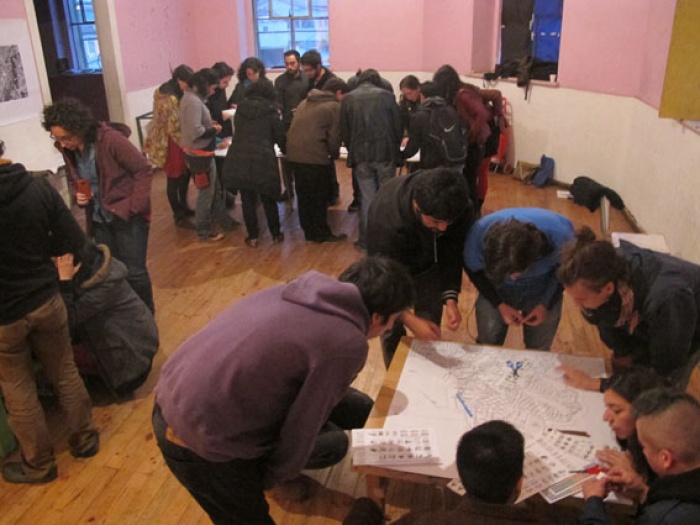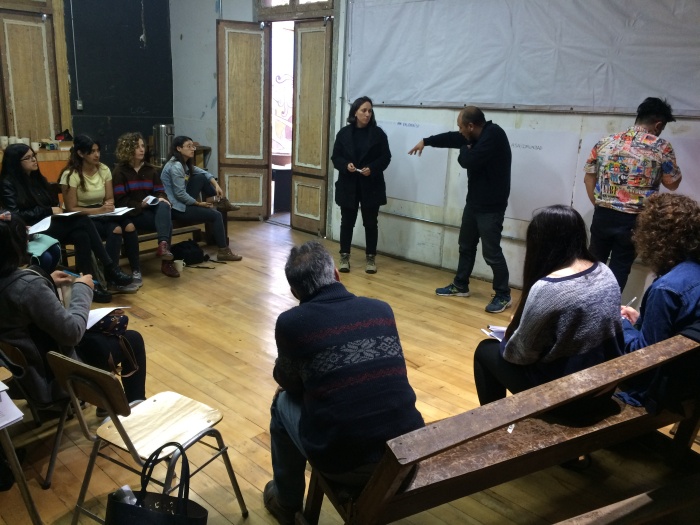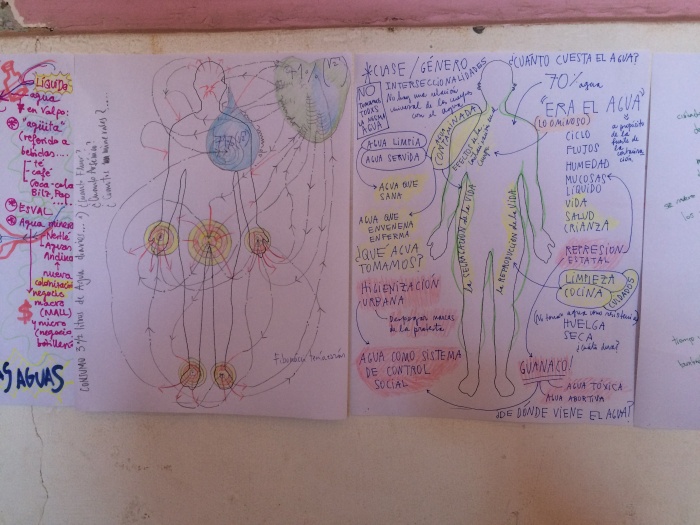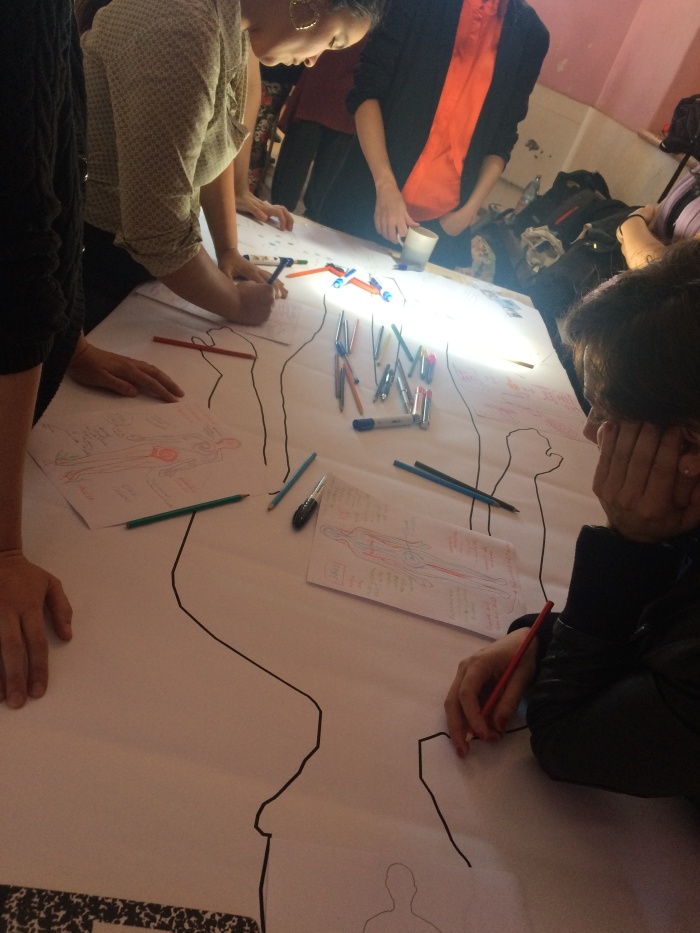
W trakcie warsztatów kolektywnej kartografii Valparaíso w 2014 roku. Uczestniczyły różne organizacje, grupy i mieszkańcy. Stworzony wraz z CRAC, Iconoclasistas (grupa argentyńska) i Espacio santa Ana from Valparaíso. Zdjęcie: Paulina E. Varas. Dzięki uprzejmości artystki
1.
In May 1991, Félix Guattari gave a lecture in Santiago, Chile, titled “The three ecologies” (after his book of the same title, published in 1989).1 He wanted to propose a series of ideas of what could be an ecological thought, as Edgar Morín had called it before. Facing an audience of ecologists, sociologists, and people already sensitive to environmental issues, the basis of Guattari’s argument was that all the old ways of life were devastated. He mentions how demographic growth, large urban concentrations, and urban ghettos were a difficult test for the planet. Today, 27 years later, we can see how this argument is still valid, especially regarding the transversal character, according to Guattari, of the current condition of the idea that “problems can solve themselves.” Following his lecture, a way to address these issues would be not to separate the environmental issues concerning nature and the city from incorporeal devastations, because it is important to understand the different machines, social, technical, and the family ecosystems as an interwoven whole. Guattari proposes ecosophy as an expansion of the concept of ecology in order to surpass the unilaterally rationalist or scientistic visions of environmental issues and he points out that “If at the heart of the ecological object we introduce ecosystemic issues, not only from social life, but also from art, the mathematical incorporeal universes, we are introducing personal dimensions, unconscious dimensions, from subjectivity and, more importantly, dimensions that I would call ethico-political.”2 In that sense, the author’s proposal is appealing to an approach that assumes the finitude of Earth, thus assuming the defense of our own humanity and of other living beings. This space of recreation constantly incorporates the defense of threatened vegetal and cultural species, and he also mentions, for instance, how poetry was in danger of extinction, thus also considering the defense of treasures of subjectivity in danger of disappearance, elements that are vital for the psychic life. Social ecology, mind ecology, and environmental ecology are three inter-related aspects and must be introduced in real life. More than just another theory, the alternatives proposed by Guattari in his lecture are not an absolute solution to these issues but possibilities under construction. Taking into account the auto-poietic character of ecosophy, that is, the possibility of unifying heterogeneous dimensions, would be vital for this approach, an example of which would be to transpose political discussions to a neighborhood project, understood as political and social or aesthetic micro-practices.
In his trip to Chile, Guattari was invited by his friend, clinical psychologist Miguel Denis Norambuena, who organized the visit together with Francisco Zegers and a group of allies. During his stay, they visited Valparaíso. Miguel remembers: “We also visited Valparaíso, its hills and kind and hospitable inhabitants, the Cerro Alegre. Guattari was dismayed by the achievements of 'real estate speculation,' the white collar urban delinquency dizzily annihilating the singularity of the hills’ landscape and houses, threatening what could become, as he would say, when we walked through the hills.”3 This experience seems to have anticipated a process of speculation in the city under the neoliberal parameters that, as of today, have fractured unique ways of life.
Today, it is possible to ask ourselves about the relevance of conceiving the sites of our common life, cities, as spaces of struggle against the global market as well as unique life spaces where practices that are still beyond the hegemonic frameworks emerge. One of our proposals at CRAC in Valparaíso is to use the cartographic tool as a way to identify whether these singularities are operating and in which way it is possible to see this critical sensibility reflected on the territory. This is why it’s important to remember that, traditionally, maps show national or communal borders, but also those power relations that precede conflicts. It’s common sense to believe that maps are exact representations of reality, although they are indeed cultural productions incorporating a range of senses, where even error and confusion are included.
From the discipline of cartography and geography some modifications have been proposed since the 1980s regarding the understanding of its subject of study, maps, seeing them now as articulators of relations and practices of power and knowledge, and that they should be understood as social constructions determined by the context that makes them emerge, and it is from that standpoint that for some authors the concept of “critical cartography” is born. In a 2006 article, the geographers Jeremy Crampton and John Krygier propose a revision of the notion of “critical cartography” on the basis of the new mapping practices and from critical theory, establishing a distance from the use of cartography by the elites as a method of domination, as a production only for “experts,” and moving towards uses by other organizations that often times on the basis of self-determination, use maps as spaces for community knowledge. Crampton and Krygier, after quoting the geographer John Pickles, point out that the latter, “rethinks mapping as the production of space, geography, place and territory as well as the political identities people have who inhabit and make up these spaces. Maps are active; they actively construct knowledge, they exercise power and they can be a powerful means of promoting social change.”[4] For these authors, one of the most notable examples of the origin of a critical thinking regarding geography has been – among others – the production and reflection on maps, created within the artistic community, that challenge representation and the role of cartography in the creation of a geographical sense. Some of the examples they provide date back to the artistic avant-garde of the first half of the 20th century, including artists such as Braque or Cézanne and the situationists and psychogeographers of the fifties and sixties, and they point out: “These latter groups sought to radically transform urban space by subverting cartography as part of a project of political resistance (...). Their ‘subversive cartographies,’ by assuming that cartography was always already political, created different arrangements of space”[5] In this sense, a critical cartography is proposed that is not focused on the limits of the nation-state only, and proposes the analysis of space as a new territory to be understood under its own internal logic. The agents building critical cartographies are no longer a unique fixed point of reference distributing the territory and its limits spatially. When these agents are the people that inhabit and produce life in the territory, limits are less fixated, the uses of spaces vary according to the experiences. Cartography can be a liberating element of the very life of that territory, an image of a changing life, in constant process.
Researcher André Mesquita has identified a series of agents collaborating to that sense of order implicit in other maps created from the heights of official knowledge about space, such as empires, states, armies, and corporations: “All these organizations collaborate to maintain the Status Quo by removing or making invisible the life experiences of the communities that freely appropriate the spaces to create their own territories, to limit certain knowledge between the people and to oppress the social forces that operate on the world in order to transform it.”6 That is, maps have been used by capitalism to arrange, for the domination of the colonizers over the colonized, for the control of public space, for the legitimation of borders, the exploitation of natural resources and common goods, etc. Mesquita’s proposal is that “maps can be transformed and the power of change that they exert can be in our hands.”7 In this sense, cartography as a process of map production and of studying its role in the political and social contexts is going to be modified when it begins to be used by artists and, sometimes in parallel, when groups or communities take into their own hands the process of reconfiguration of their neighborhoods or the ways violence can affect subjective and collective ways of life.
The map can be used as a tool for social transformation, but at the same time it’s a possibility for subjective transformation and the opportunity to create new liberating and singular narratives that eventually connect with common spaces. In her book Sentimental Cartography: Contemporary Transformations of Desire, published in Brazil in 1991, Suely Rolnik refers to the use of the notion of cartography in a specific sense: “For geographers, cartography, unlike the map, which is a representation of a static whole, is a design that accompanies and is made at the same time that the movements transforming the landscape. Psycho-social landscapes are also cartographable.”8 (Rolnik, 2014). It is through her own body that the sensitive cartographer proposed by Rolnik maps the state of things and creates meaning, exchanging safety for uncertainties, risking reason for chance. What cartographies register the interval of our relations and knowledge? How can we map the power relations that impact us and modify us? One of Rolnik’s proposals is to become those sensitive cartographers for whom landscapes are not physical anymore, maps no longer refer to the fixated and static terrain and become psycho-social, the movements and transformations of the landscape thus make cartography a tool for subjective knowledge and knowledge about our relationship with the world. She says: “Cartography, in this case, accompanies and it is made while certain worlds disintegrate and lose their meaning, and other worlds are formed: worlds, created to express contemporary affections, with regards to which current universes become obsolete.”9 That is, without a transformation of our subjective references we could not trace those other routes required by a situated work. An interweaving of physical territories affected by the voracious hunger of real estate projects or the plundering of raw materials, together with an awareness of their impact on the subjective territories or by issues located in the contemporary subjectivity and the ways of subjection that presents us only one way of life within capitalism. To confront this unilateral view, a multiplicity of cartographies, territories, and local existences is proposed, situated within that specificity. In this sense, it is worth remembering that the notion of “situated knowledges” is a term originally used by Donna Haraway, who studies the crisis of the Euro-American versions of feminist humanism in its adoption of canonic narratives deeply rooted in racism and colonialism. Among other things, she postulates feminist thought as a way to challenge established knowledge. So, considering that knowledges are mediated by the subjects producing them, it is not possible to find neutrality or objectivity in the way to produce or what is produced as knowledge.
This subjective process is part of what can be called a transformative cartography, which is not only situated in the physical territory but is also affected by temporality, when can it begin to become a territory? What influences that active, stabbing, intermittent pulse, that allows us not to return through the same path? There is no way back from transformation, a path is not traveled in order to return through it, it is not an extractivist action that exploits the territory but one that transforms it into something fertile for future resignifications and becomings without time or fixated histories.
2. To cartograph ourselves, to feel the city
In April 2014, the city of Valparaíso in Chile, experienced one of the largest rural-urban fires, which consumed neighborhoods where more than 3,000 people lived. A few days after the fire, we organized a “Collective mapping workshop.” At the same time, the workshop consisted in a critical reflection on the ways the city is produced from its representations and subjectivities, as well as in a collective construction of an integrative and binding vision about the major issues of the city.
The mapping workshop was the result of inviting the Argentine duo Iconoclasistas and took place at the Espacio Santa Ana, a popular and self-managed community center, located on the Cordillera Hill, one of the 44 hills of the city. This self-managed space is located next to the first affordable housing complex for workers in Chile, built in 1870, the Población Obrera La Unión (“La Unión Workers’ Neighborhood”), recovered at the turn of this century by the same inhabitants as a space for collective housing, with a genealogy of practices of social and cultural appropriation in the hill.10 The attendance to the mapping workshop was broad and heterogeneous, the participants came from diverse social, political, student, and cultural backgrounds. We worked for 3 days on 4 maps of Valparaíso with varied graphic elements such as generic icons or others especially designed for the city, a chronology of milestones of the city since the sixties and a general outlook of the hills in order to give physical and morphological context to the city. Thus, the main problematic knots emerged, including what areas were victims of elitization under processes of gentrification and what areas were abandoned by the public administration, which is precisely where fires or rain-related accidents take place, among others. “During the workshop, the debate drifted toward alternative concepts of the city, thinking of places where the city becomes inclusive and its spaces, both public and common, are democratized. The participants conceptualized the ‘fictions’ that the government creates discursively in order to sell the citizens concepts such as ‘development’ and ‘innovation,’ in the face of the growth of a neoliberal city extending itself without including them and making their lives more precarious, from the different kinds of work to the ways associativity and collective exercises are represented. Another point was the progressive weakening, almost complete loss, of the bond between the inhabitant of Valparaíso and the sea, due to the different projects of commodification and privatization of the access to it.”11 The workshop was also a place of encounter for many, in a time of crisis due to the fires, a moment of vulnerability. In that context, this experience of action and participation revitalized social bonds and provided meaning to a series of activities that were taking place in the city in support of those suffering the outcomes of the fire. That condition of “bodies affected” by the living conditions of the city, under inequality and inequity, activated in every participant another way of mapping, one that it is not only about the physical territory, but also about the subjective trajectories that we could share in the 3-day workshop and its intervals.
In the weeks following the workshop, a group in Valparaíso worked in the systematization of the great amount of information contained oin the 4 maps, which was later presented and we also talked about ways of organizing or include vital matters in the process of collective mapping. Finally, Iconoclasistas, in Argentina, worked with CRAC on the design of the poster, which was printed in Valparaíso.
The poster was titled “¿Te invité yo a vivir aquí?” (“Did I invite you to live here?”), exposing the cynical answer by Valparaíso’s mayor when one of the affected by the fire demanded a solution. This answer also reflects the last 40 years of housing public policies in Chile, where the most important aspect is financial outcomes, rather than the good life of its inhabitants. “The printed poster also points out a series of issues: the port, 86% of which is private, life in former popular neighborhoods affected by gentrification processes unleashed by real estate speculation, the displacement of neighbors and the privatization of public spaces, privileging thus the profile of a city built for the eventual visitor. In contrast, the presence of cultural, social, and community spaces, managed and used by students and teachers, workers and militants, who, together with a generous and alert community, gather to think and activate transformative practices from the standpoint of community self-management and network activity.”12 The poster was formally and informally distributed throughout the city, posted on the walls of community and social centers, also at public offices or the offices of university professors. The CRAC platform has been invited to present the process of the map to different universities and community spaces. A version of the poster in a large format of over 2 meters was exhibited in the Contemporary Art Museum during the exhibition of art and activism titled “The workers of the Moon,” curated by Loreto Garín and Federico Zukerfeld, between November 2014 and January 2015. For that occasion, together with members of Espacio Santa Ana, we deployed slogans from the poster by printing silkscreened flyers which were given to those attending the inauguration.

Pierwsze spotkanie grupy kolektywnej kartografii wody w Valparaiso. Uczestnicy dzielą się pierwszymi pomysłami. Niektóre z nich nawiązują do trzech ekologii Guattariego. Zdjęcie: Paulina E. Varas. Dzięki uprzejmości artystki

Zbliżenie na małe mapy ciał powiązanych ze szczególnymi uczuciami lub subiektywnie odczuwanymi efektami kryzysu wodnego w Valparaíso. Zdjęcie: Paulina E. Varas. Dzięki uprzejmości artystki.

Javiera rozrysowuje pomysły na pierwszym diagramie stworzonym w ramach kolektywnej kartografii na pierwszym spotkaniu. Zdjęcie: Paulina E. Varas. Dzięki uprzejmości artystki

Grupa uczestników dyskutuje, rysuje i zapisuje informacje i doświadczenia związane z ich własnymi ciałami w kontekście kryzysu wodnego w Valparaíso. Zdjęcie: Paulina E. Varas. Dzięki uprzejmości artystki
3. Water as a possibility
This experience of a critical cartography activated in us the material need of making maps to locate issues and to visualize the points where we should situate ourselves in order to reflect in the present upon our life in the city. This is why, in 2017, we began a new process to carry out a cartography of water as an environmental, cultural, social, and subjective problem. Valparaíso is running out of water, the reserves will become a problem in a few years, so we asked ourselves, how do we act regarding water as a vital resource? And this involves another question, what kind of life do we want? It is going to be a map about the care taken for life and the ways of life we can design for Valparaíso. In dialogueue with some of the ideas raised by Guattari duringin his visit to Chile, we returned to this ecosophic view of the issues we experience, and a group of people (Soledad León, José Llano, Javiera Manzi, Isidro Parraguez, Nahuel Quiroga, and Paulina Varas) developed a collective workshop to which we invited other people to think of the issue of water, not only in the georeferenced territory of the city but also in connection with the body. In a two-day workshop at the Espacio Santa Ana in Valparaíso, we held conversations and drew, on maps and bodies, the possible ways of confronting this issue, in order to project a future systematized and designed map (in 2018) concerning water, which we saw as an issue that was transversal to another series of problems affecting us, which are necessary to review again sensibly.
Translated from the Spanish by Pablo Abufom Silva
Additional bibliography:
Haraway, D. (1991). Ciencia, cyborgs y mujeres. La reinvención de la naturaleza (Valencia: Ediciones Cátedra / Universitat de València / Instituto de la mujer). English original (1991):"A Cyborg Manifesto: Science, Technology, and Socialist-Feminism in the Late Twentieth Century." Simians, Cyborgs and Women: The Reinvention of Nature. Available at: https://web.archive.org/web/20120214194015/http://www.stanford.edu/dept/HPS/Haraway/CyborgManifesto.html [accessed 05.02.2018].
BIO
Paulina Varas is a researcher and professor at Campus Creativo in Universidad Andrés Bello in Chile. She received a PhD in the History and Theory of Art from the Universidad de Barcelona. She is co-coordinator of CRAC Valparaíso, a collaborative non-profit research platform that works in the city of Valparaíso. With artist residencies, research action, critical pedagogies and radical architecture, CRAC proposes a critical entanglement with the public sphere, the city and the territory as a network of connections and associations of social experiments. Since 2007, she has been a member of the Red Conceptualismos del Sur where she has participated in a number of publications, public presentations, support operations and working groups. She has authored or co-authored the books: Muntadas en Latinoamérica (Caldas, 2009); Revisión/Remisión de la historiografía de las artes visuales chilenas contemporáneas (Santiago de Chile, 2011); “Guillermo Deisler. Archivo, textos e imágenes en acción” (Santiago de Chile 2013) and “Luz Donoso. El arte y la acción en el presente” (2018). Amongst her curatorial projects, she has notably curated or co-curated Cierto tipo de poética política, (Valparaíso 2008); Subversive Practices, Art under conditions of political repression, 60s-80s South America-Europe, (Stuttgart, 2009); Valparaíso: Intervenciones, (Valparaíso 2010); “Una acción hecha por otro es una obra de la Luz Donoso” (Santiago 2011); “Artist for Democracy: el archivo de Cecilia Vicuña” (Santiago 2014).
[1] Félix Guattari, Les trois écologies, Galilée, Paris 1989.
[2] Félix Guattari El devenir de la subjetividad, Santiago de Chile, Dolmen ediciones, 1998, p. 44
[3] Miguel Denis Norambuena “Introducción” en: Félix Guattari El devenir de la subjetividad, Santiago de Chile, Dolmen ediciones, 1998, p. 19
[4] Jeremy Crampton, John Krygier, An Introduction to Critical Cartography, “ACME: An International E-Journal for Critical Geographies” 1, 4, p. 15, online: http://acmejournal.org/index.php/acme/article/view/723/585, last accessed, 30.10.2015.
[5] Ibid, p. 17.
[6] André Mesquita, Mapas disidentes. Proposiciones sobre un mundo en crisis (1960–2010) [Dissenting maps: Propositions on a world in crisis (1960–2010)], Doctoral Dissertation, Universidad de São Paulo 2013, p. 12.
[7] Ibid, p. 11.
[8] Suely Rolnik, Cartografía sentimental. Transformaciones contemporáneas del deseo [Sentimental Cartography: Contemporary transformation of desires], www.unsam.edu.ar/lecturamundi/sitio/wp-content/.../CartografIa-sentimental.docx. [last accessed: 5.02.2018]
[9] Ibid.
[10] See: Maximiliano Soto, Nahuel Quiroga Corvalán, Marcelo González Cisternas, Prácticas de reapropiación de espacios comunitarios en el cerro cordillera. Un análisis etnográfico del taller de Acción Comunitaria (TAC), La Población Obrera de la Unión y el Espacio Santa Ana “Márgenes” 14 (11), 2014, p. 52–62, online; http://revistas.uv.cl/index.php/margenes/article/view/318/285, [last accessed: 5.02.2018].
[11] Iconoclasistas, Cartografía crítica de Valparaíso [Critical cartography of Valparaíso], online: http://www.iconoclasistas.net/valparaiso-chile/ ultima visita 3/1/2018, [last accessed: 5.02.2018].
[12] Ibid.



